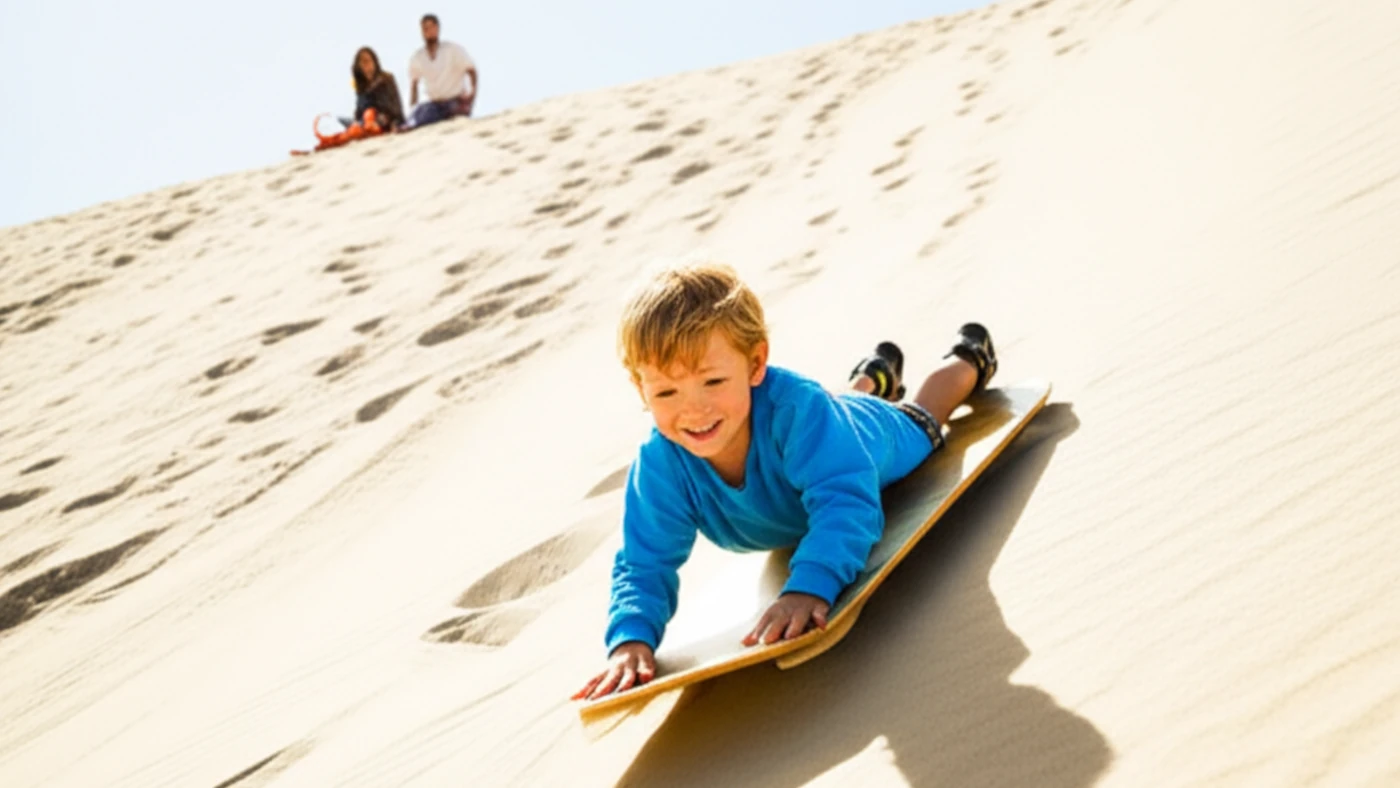Sandboarding is a dynamic board sport that shares fundamental similarities with surfing, skateboarding, and snowboarding, yet is uniquely adapted for descending sand dunes.
This activity involves gliding down sand hills on a specially designed board, which is often waxed to optimize its slide.
The sport offers various riding styles, incluido standard sandboarding where the rider stands with one foot in front of the other (similar to surfing), prone sandboarding where participants lie on their stomach and steer with their hands (trineo de arena), and terrain variations such as abordaje de volcanes.
Abajo, some of the most commonly asked questions regarding this exciting activity.

What equipment do I need for sandboarding?
Essential gear for sandboaring includes:
- sandboard: Choose a type that suits your riding style (longboard, shortboard, twin tip).
- Fijaciones de sandboard: Comfortable and well-fitting bindings to attach your feet to the board. Simple Velcro-style straps are common.
- Sandboard Wax: Crucial for reducing friction and enabling glide.
- Goggles/Sunglasses: Protect your eyes from flying sand and sun.
- Proteccion solar: Sunscreen and a hat are vital in sandy environments.
- Appropriate Clothing: Dress in layers if in a desert location, as temperatures can vary a lot during the day. Wear closed-toes shoes to protect your feet from hot sand.
What is the best material for a sandboard?
Sandboards are typically made from durable, low-friction materials designed to withstand the abrasive nature of sand. Common choices include:
- Hard composites or laminated materials (like Formica): These provide a robust and smooth base for optimal gliding.
- Pressed pine or solid wood boards: Thicker than snowboards, these help the board stay atop the sand rather than sinking in.
What wax should I use for sandboarding?
Using the right wax is crucial for a smooth and fast ride.
- Dedicated Sandboard Wax: Brands like Doctor Dune’s Speed Wax are highly recommended. These are often formulated with static block and race additives for optimal all-around performance.
- Paraffin-based Wax: Suitable for dry sand conditions.
- Tree Resin or Beeswax-based Wax: Better for wet or cold sand conditions, as they won’t harden at lower temperatures.
- Candle Wax (Last Resort): In a pinch, candle wax can be used, but it’s pure paraffin and may need to be melted and mixed with oil (like virgin coconut oil) to be spreadable. It won’t perform as well as commercial sandboard waxes.
How do I apply sandboard wax?
Apply a light coat of sandboard wax by rubbing it over the base of your board. A few streaks from front to back are generally enough between every 1-2 paseos.
Avoid applying too much, as this can cause the board to grip the sand rather than slide. For longer runs, adults may need to reapply a light coat before each run.
Is sandboarding easier on wet or dry sand?
There are varying perspectives on this:
- Dry Sand: Often preferred for greater control, as its lower density allows for easier carving and steering. Some sources indicate boards perform better in dry sand.
- Wet/Hard Sand: Can lead to faster speeds but with less control. If the sand is only wet on the surface, it can stick to the board in patches and slow you down.
Por último, finding the driest sand is often recommended for the best experience and control.
How much wax should I use?
Apply wax sparingly. A few streaks from front to bottom are usually sufficient for 1-2 runs. Too much wax can create too much grip and hinder your slide.
Waxing before each ride, and polishing the laminate bottom beforehand, will ensure optimal performance.
Can I sandboard year-round?
Sí, sandboarding can generally be enjoyed year-round.
- Winter: Often considered the best time due to more accessible dunes and smaller crowds.
- Summer: Offers a challenge with hotter sand, which can be good for advanced tricks. Sin embargo, avoid extreme heat during the day for safety.
What are some basic sandboarding safety tips?
- Stay Low, Lean Back: Crouch low on the board with most of your weight on your uphill foot. Avoid standing too tall or leaning forward when nervous.
- Fall Safely: If you need to bail, try to fall backward or to the side to avoid getting sand in your mouth.
- Terrain Awareness: Be mindful of obstacles like rocks or trees. Only sandboard on designated areas away from vegetation!
- Hydration & Proteccion solar: Drink plenty of water and use sunscreen in hot desert climates.
- Group Awareness: Be aware of other riders to prevent collisions.
Do I need prior experience to sandboard?
No, you don’t necessarily need prior experience. Sandboarding is often compared to snowboarding or surfing, and while experience in those sports can be helpful, it’s not a prerequisite.
Beginners should start on smaller, gentler dunes to get accustomed to the board and the sensation of gliding on sand. Many tour operators offer beginner-friendly slopes and guidance to help new riders learn the basics.
¿Es peligroso el sandboard??
Like any extreme sport, sandboarding carries inherent risks, but it can be enjoyed safely with proper precautions. The main dangers include falls, collisions with obstacles, and exposure to the elements (sol, calor).
Make sure to wear appropriate safety gear (casco, gafas de protección), understanding basic techniques, and starting on smaller dunes can significantly reduce risks.
Many sandboards also feature simple foot straps, allowing riders to easily detach from the board in a fall, which can be safer for beginners.
Always stick to designated areas without vegetation or other obstacles. People who have been severely injured or even died from sandboarding, did so because they were sandboarding alone and away from designated areas. Be safe!
Ubicaciones de sandboard
deportes de arena
sandboarding trineo de arena abordaje de volcanes | Esquí en la arena Cometas en la arena |  Cometas en la arena |  Viajes al desierto acampar en el desierto Correr por el desierto |

Cheri Sanders es nativo de Arizona, escritor, y entusiastas al aire libre que cree que las mejores cosas de la vida se encuentran por el camino golpeado, a menudo con sus perros a su lado. Especializándose en viajes, al aire libre, y belleza, Cheri narra las aventuras de caminar por el suroeste y más allá.

